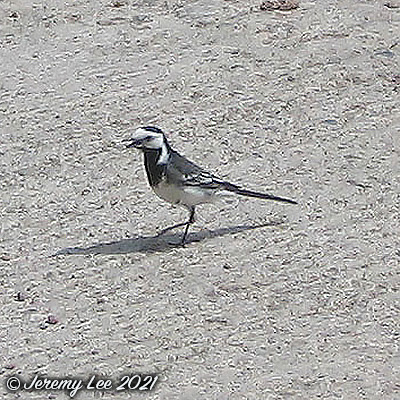
 |
|
Scientific Classifications explained » Amphibians » Ants » Aphids » Bees » Beetles » Birds » Bugs » Butterflies » Caterpillars » Damselflies » Dragonflies » Earwigs » Flies » Frog/Leafhoppers » Fungi » Galls » Grasshoppers » Harvestmen » Hoverflies » Lacewings » Ladybirds » Leaf Mines » Lichens » Mammals » Millipedes » Mosses » Moths » Sawflies » Slugs » Snails » Spiders » Trees » Wasps » Wild Flowers » Woodlice |
UK Nature > Birds > Motacilla alba

Scientific Name: Motacilla alba Common Name: Pied Wagtail Motacilla alba, more commonly known as the Pied Wagtail, is a small (approx. 18cm in length), long-tailed and rather delicate-looking black and white bird. When not standing still and manically wagging its tail up and down it can be seen dashing about over lawns or car parks in search of food. It often calls when in its undulating flight and frequently gathers at dusk to form large roosts in city centres. They eat insects and their larvae, small molluscs, worms and sometimes seeds. Most nests are to be found in holes, clefts and ledges, usually sited in banks, ditches and buildings. Old nests of other birds, such as Blackbirds (Turdus merula), are sometimes used. Both sexes build the nest, with the female taking the larger share, and completing the lining of hair, wool and feathers. Pied Wagtails can be found in many and varied open places including fields, farmyards, parks and meadows. However, it does display a distinct preference to areas in the vicinity of water. Resident and common throughout the UK. |
|

https://www.uknature.co.uk is a website dedicated to showing the immense diversity of UK nature and wildlife. Our vast range of habitats, from lowland arable to snow covered mountains, from storm-ravaged coastlines to peaceful inland freshwater lakes and rivers, from dry, sandy heaths to deciduous and coniferous forests, all these habitats contribute to the abundance of UK nature. We have wild birds in huge numbers either residing or visiting our shores (597 recorded species as at July 2013) and we must also not forget the humble back garden with its grass lawns, flower beds filled with nectar rich flowers, shrubs and trees, all designed to attract huge numbers of insects such as bees, moths, butterflies and hoverflies; and finally the small ponds which provide safe havens for frogs, toads, newts and even slow worms and grass snakes. www.uknature.co.uk is the showcase for my personal passion, photographing uknature in all its glory. I sincerely hope you all enjoy the fruits of my labours. This site and all images contained therein is © Jeremy Lee 2004 - 2021. All Rights Reserved. Site design by Jeremy Lee. Site development & IT Support by Stuart Lee. |